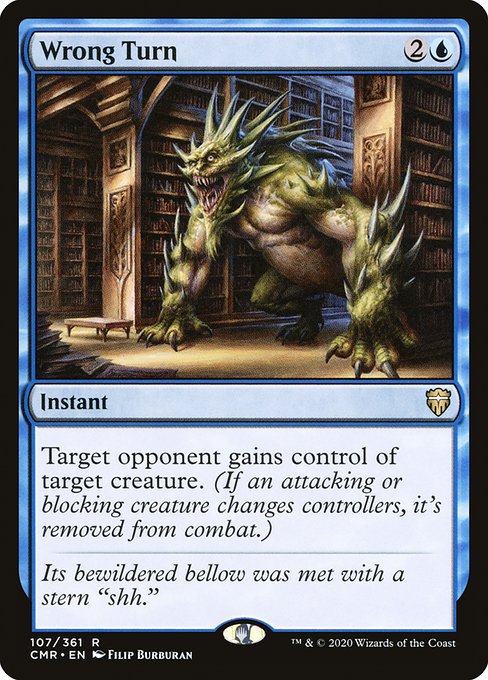
Image courtesy of Scryfall.com
How Wrong Turn Interacts With Planeswalkers in MTG
Blue instant tricks are the lifeblood of control-heavy decks, and Wrong Turn stands out as a crisp, clever tool in any blue player’s arsenal. For those who love the delicate ballet of planeswalkers and combat math, this 2 mana spell—{2}{U}—lets you tilt the battlefield with surgical efficiency. Its text is simple, but the implications ripple through combat steps, loyalty counters, and late-game inevitabilities. And yes, it’s got that classic blue flavor: outthinking, outmaneuvering, and quietly rewriting the terms of engagement 🧙♂️🔥.
The core effect is straightforward: you give an opponent control of a target creature. The twist that makes it sing in planeswalker mirrors is the combat rule that follows: “If an attacking or blocking creature changes controllers, it's removed from combat.” That’s not just a mouthful of rules text—it's a strategic doorway. When you flick Wrong Turn at the right moment, you can pull a threatening attacker away from a planeswalker your opponent is defending, or flip the board so a planned onslaught against a walker fizzles out. The blue player’s toolkit suddenly has a precise, tempo-drenched answer to the old problem of a planeswalker being pummeled into oblivion by a stubborn creature 🧭.
Its bewildered bellow was met with a stern "shh."
Commander Legends, the set that birthed this rare, emphasizes playful political spice and unique every-game scenarios. Wrong Turn fits that mold perfectly. With a mana cost of just 2U, it’s an often-splashable tempo play that rewards timing and anticipation. The card’s rarity—rare—hints at the power of a single, well-timed 순간 in multiplayer chaos where the board state can shift with a single slick decision. In practice, you’ll often cast it during combat after your opponent declares attackers but before blockers are chosen, or in response to a declared attack that targets your own walker. The instant speed lets you respond to threats in real time, which is the heartbeat of blue control style—the art of turning an opponent’s momentum into your own advantage 🧠💧.
Practical play patterns that center planeswalkers
- Defensive disengage: Your planeswalker is under fire from a single creature or a coordinated pair. Casting Wrong Turn on the attacker and giving it to the opponent ends that specific attack, preserving loyalty on your walker and neutralizing an immediate threat. Remember: the attacking creature is removed from combat, so the walker survives this turn and may survive the next if you position your defenses well 🛡️.
- Political tempo in multiplayer: In a game with three or more players, Wrong Turn can be a diplomacy tool. The moment you grant control of a creature to a third party, you can shape the table’s social dynamics—trading future attack priorities, and sometimes triggering alliances and counter-alliances that swing the game in your direction 🎭.
- Flicker-friendly sequencing: If you’re running blink or bounce effects, Wrong Turn becomes even sweeter: you can remove a problematic attacker, only to re-use that same creature later as a denial to another player or as bait for another tactic. The cyclical nature of blue control thrives on these little, well-timed misdirections 🔁.
- Deck-building considerations: Because the spell targets a creature and the effect can disrupt an adversary’s plans around planeswalkers, it pairs nicely with other control staples—counterspells, bounce effects, and defensive creatures that protect walkers while you set up your endgame. In the right shell, Wrong Turn helps you weather the storm while you draw into the bigger finishers ⛈️.
Flavor-wise, the card’s flavor text—“Its bewildered bellow was met with a stern 'shh.'”—reads as blue through and through: misdirection wrapped in calm, a reminder that in the universe of planeswalkers, the loudest show often hides the quiet manipulation that wins games. The artwork, by Filip Burburan, communicates a sense of mischief and precision that fans of blue magic have come to expect. The card remains playable in Legacy, Vintage, and especially Commander formats, where the commander vs. board dynamic and political strings get pulled in every session. Collectors may notice the nonfoil and foil distinctions, with nonfoil around a modest price point and foil enjoying a premium—though both reflect the card’s niche appeal in a world of splashy, showy rares 🧩.
As you square your blue mana into a well-timed Wrong Turn, you’re not just removing a threat—you’re reconfiguring the battlefield’s social geometry. A single instant can flip the script on a walker’s trajectory, extend your defense, or reshuffle a combat nightmare into a stalemate that buys you time to deploy a more decisive plan. In that sense, Wrong Turn is more than a tempo play; it’s a strategic lens into how blue decks navigate the most delicate moments of magic—the moments when life totals, loyalty counters, and the next great draw all hinge on a precise, well-placed interruption 🧙♂️🎯.
For those who like the crossover vibe between MTG strategy and real-world gear, you’ll notice how other facets of gamer life intersect with the hobby. If you’re often on the move to Friday Night Magic or a regional event, a slim, glossy polycarbonate phone case can keep your device protected—just like your plan to protect a beloved planeswalker from an unexpected crash of combat. That practical detail becomes part of your MTG culture, where play mats, sleeves, and even phone cases become an extension of how you approach the table 🧰🎲.
To dive deeper into the wider world of game design, culture, and the ongoing conversation about how classic ideas evolve with new tech and new rules, check out these related reads from our network. They echo the same curiosity that makes Wrong Turn such a clever puzzle in play.
Slim Glossy Polycarbonate Phone Case for iPhone 16More from our network
- https://transparent-paper.shop/blog/post/blue-hot-star-temperature-signals-early-life-stage/
- https://crypto-acolytes.xyz/blog/post/how-to-use-solscan-effectively-a-practical-guide/
- https://crypto-acolytes.xyz/blog/post/nostalgia-fuels-remakes-the-pull-of-reimagined-classics/
- https://crypto-acolytes.xyz/blog/post/culture-clash-gamers-vs-nft-flippers/
- https://crypto-acolytes.xyz/blog/post/designing-dynamic-ai-npc-dialogue-for-immersive-games/